If you’ve got a small balcony, don’t let limited space stop you; you can transform it into a green oasis with smart ideas. Start by evaluating your area—measure the width (e.g., 3 feet) and height (e.g., 5 feet)—to plan layouts. Use vertical and container options to maximize every inch. Curious about specific setups like hanging baskets or herb pots? Stick around for practical tips!

Contents
- 1 Maximize Space With Vertical Planters
- 2 Use Hanging Baskets for Added Greenery
- 3 Opt for Compact Container Gardening
- 4 Incorporate Tiered Plant Stands
- 5 Grow Herbs in Small Pots
- 6 Repurpose Everyday Items as Planters
- 7 Choose Low-Maintenance Plants
- 8 Create a Cozy Corner With Potted Shrubs
- 9 Add Color With Seasonal Flowers
- 10 Install a Simple Trellis for Climbers
Maximize Space With Vertical Planters
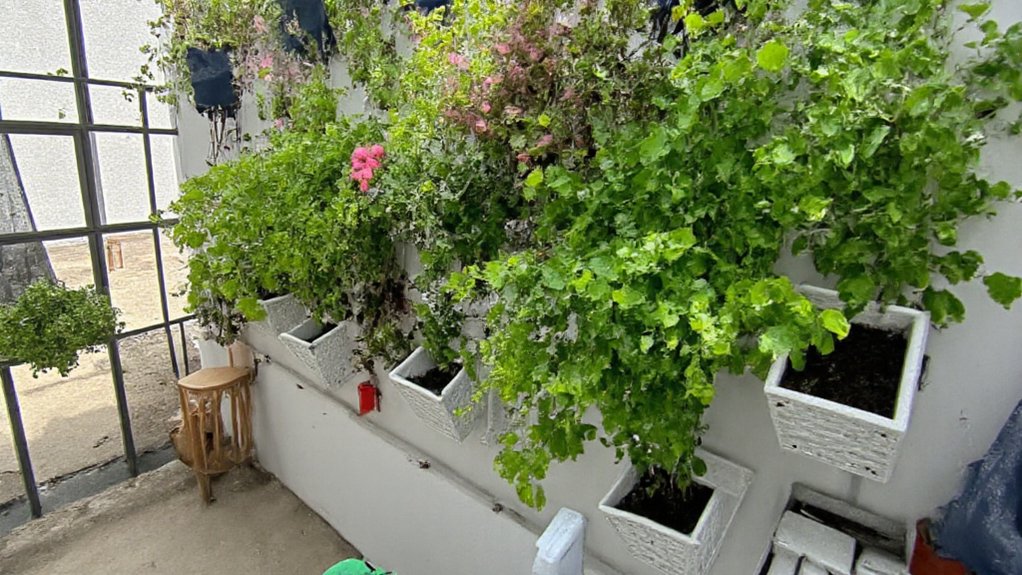
Vertical planters are a fantastic way to maximize space on a tiny balcony, allowing you to grow a variety of plants without taking up valuable floor area. By utilizing walls, railings, or hanging structures, you can create a lush, green environment even in the smallest of spaces. These planters come in various forms, such as wall-mounted pockets, tiered stands, or hanging baskets, making it easy to customize your setup based on your balcony’s layout and style.
To get started, consider installing a vertical garden system on a sturdy wall or fence, ensuring it receives adequate sunlight for your chosen plants. You can grow herbs, succulents, or small flowers in these planters, stacking them to create a living wall effect. Additionally, hanging pots or railing planters can add greenery without cluttering the floor, leaving room for seating or other decor. Vertical gardening not only saves space but also adds a striking visual element to your balcony.
Use Hanging Baskets for Added Greenery

Hanging baskets are a fantastic way to add greenery to a tiny balcony without taking up valuable floor space. By suspending plants from railings, ceilings, or wall-mounted hooks, you can create a lush, vertical garden that enhances the aesthetic appeal of your outdoor area. Choose baskets with sturdy chains or ropes and confirm they are securely fastened to support the weight of the soil and plants.
Opt for a variety of plants in your hanging baskets, such as trailing flowers like petunias or ivy, or even small herbs and succulents for a mix of beauty and functionality. Make sure to evaluate the sunlight and watering needs of the plants you select, as hanging baskets can dry out faster than ground-level pots. This simple addition can transform your balcony into a vibrant, green oasis with minimal effort.
Opt for Compact Container Gardening
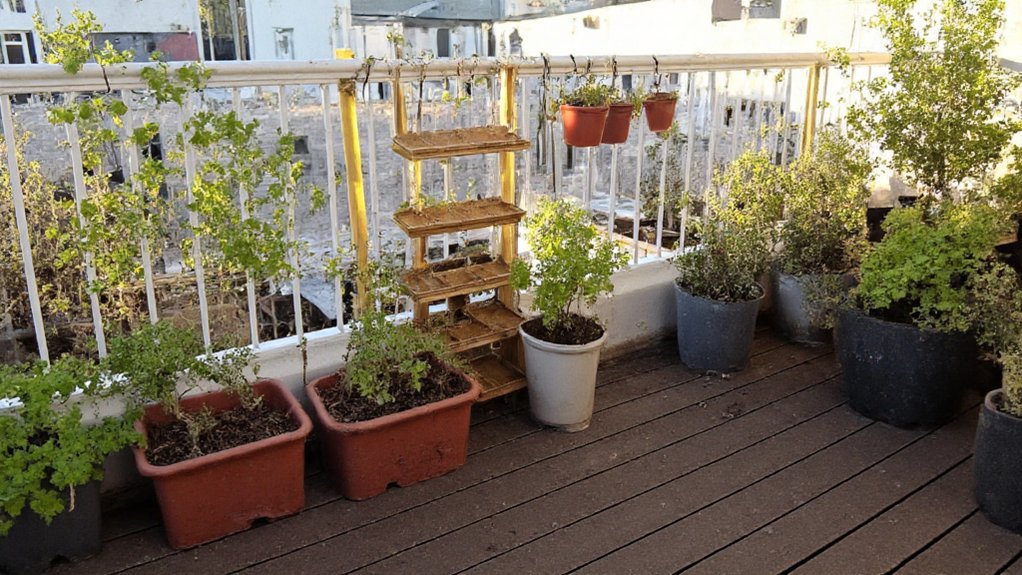
Compact container gardening is an ideal solution for tiny balcony spaces, allowing beginners to grow a variety of plants without needing extensive room. By using pots, hanging baskets, or small raised beds, you can maximize vertical and horizontal space while keeping your garden manageable. Containers come in various sizes, shapes, and materials, making it easy to match them with your balcony’s style and the specific needs of your plants, such as drainage and depth.
This method also offers flexibility, as containers can be moved to optimize sunlight exposure or protect plants from harsh weather. For beginners, starting with compact containers means less commitment and easier maintenance, while still providing the joy of nurturing herbs, flowers, or even small vegetables right on your balcony.
Incorporate Tiered Plant Stands

Incorporating tiered plant stands is an excellent way to maximize space on a tiny balcony while adding visual interest to your garden. These stands allow you to arrange plants at different heights, making efficient use of vertical space and creating a layered, lush look. They are perfect for displaying a variety of plants, from trailing vines to small potted flowers, without cluttering the limited floor area.
Choose tiered stands made of weather-resistant materials like metal or treated wood to withstand outdoor conditions. Place taller or heavier plants on the lower tiers for stability, and lighter or cascading plants on the upper levels to create a balanced and dynamic display. This setup not only optimizes space but also makes it easier to care for your plants by keeping them organized and accessible.
Grow Herbs in Small Pots
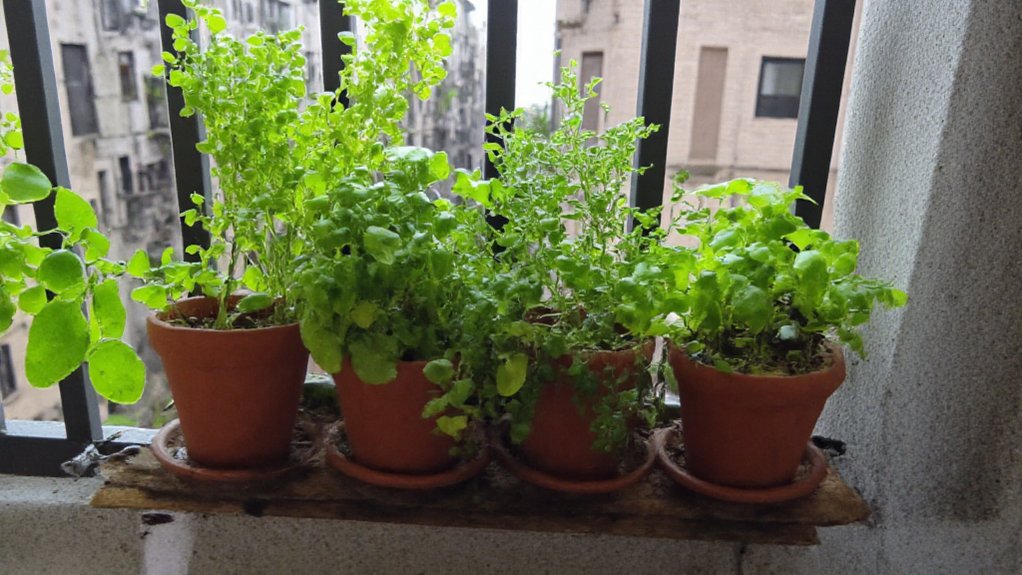
Growing herbs in small pots is an excellent way to start a tiny balcony garden, especially for beginners. Herbs like basil, mint, thyme, and rosemary are easy to grow, require minimal space, and thrive in containers. Simply choose small pots or containers with drainage holes, fill them with well-draining potting soil, and place them in a spot on your balcony that gets at least 4-6 hours of sunlight daily.
Water the herbs regularly, ensuring the soil stays moist but not waterlogged, and trim them often to encourage bushy growth. Not only do these herbs add greenery to your balcony, but they also provide fresh flavors for your cooking, making them both practical and rewarding to grow.
Repurpose Everyday Items as Planters
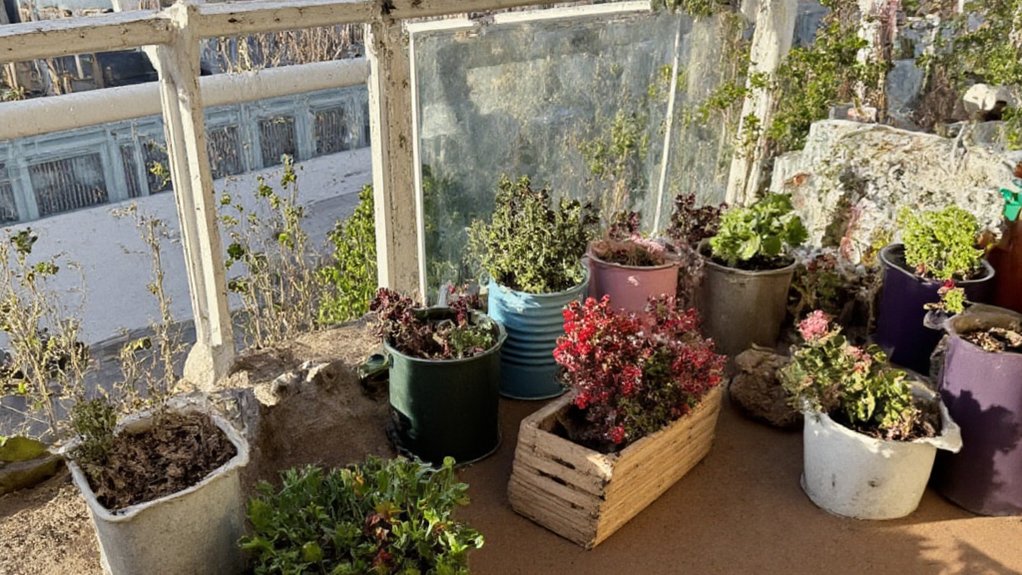
Repurposing everyday items as planters is a creative and budget-friendly way to enhance your tiny balcony garden. Common household objects like old tin cans, mason jars, wooden crates, or even broken teapots can be transformed into unique containers for your plants. Simply clean the items, provide proper drainage by adding holes if needed, and fill them with soil to create a quirky, personalized look for your space.
This approach not only reduces waste but also allows you to experiment with different styles and textures. For instance, a colander can become a hanging planter for trailing plants, while an old ladder can serve as a vertical garden structure. By thinking outside the box, you can turn ordinary items into functional and eye-catching planters that maximize your limited balcony space.
Choose Low-Maintenance Plants
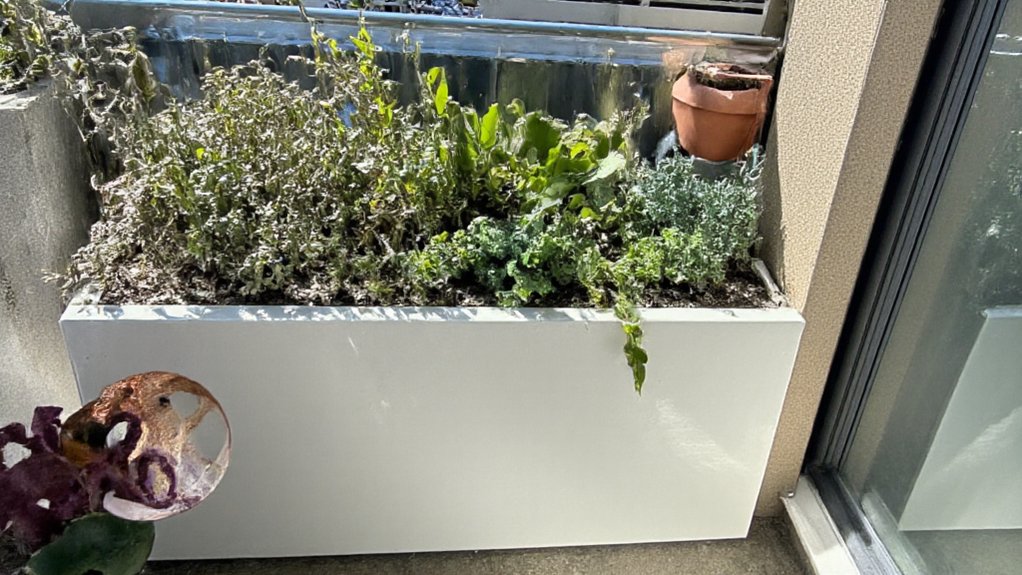
Choosing low-maintenance plants is a smart strategy for beginners creating a tiny balcony garden. These plants require minimal care, making them ideal for small spaces where time and effort may be limited. Opt for varieties like succulents, cacti, or herbs such as basil and mint, which thrive with little watering and attention. These plants are often drought-tolerant and can handle varying sunlight conditions, perfect for a balcony environment.
Additionally, consider hardy perennials or annuals like marigolds or petunias, which add color without demanding constant upkeep. Look for plants that suit your balcony’s light and weather conditions to guarantee they flourish with basic care. By starting with low-maintenance options, you can build confidence in gardening while keeping your space vibrant and green.
Create a Cozy Corner With Potted Shrubs
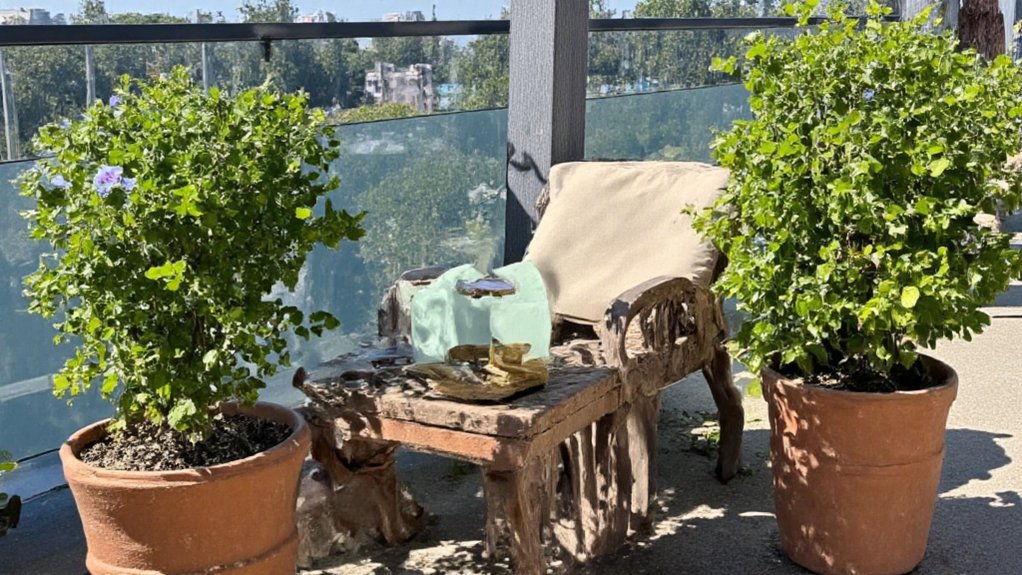
Creating a cozy corner with potted shrubs is a fantastic way to transform a small balcony into a private, green retreat. Choose compact shrubs like boxwood, dwarf hydrangeas, or small evergreens that thrive in containers and suit your climate. Place these potted shrubs in a corner of your balcony to define the space, adding a sense of enclosure and intimacy. Opt for decorative pots or planters that match your style to enhance the aesthetic appeal.
To elevate the cozy vibe, arrange the shrubs at varying heights using plant stands or small tables, and consider adding soft outdoor cushions or a small chair nearby for a relaxing nook. Incorporate low-maintenance shrubs to keep upkeep simple, and guarantee proper drainage in the pots to prevent waterlogging. This setup not only maximizes limited space but also brings a touch of nature to your urban oasis.
Add Color With Seasonal Flowers
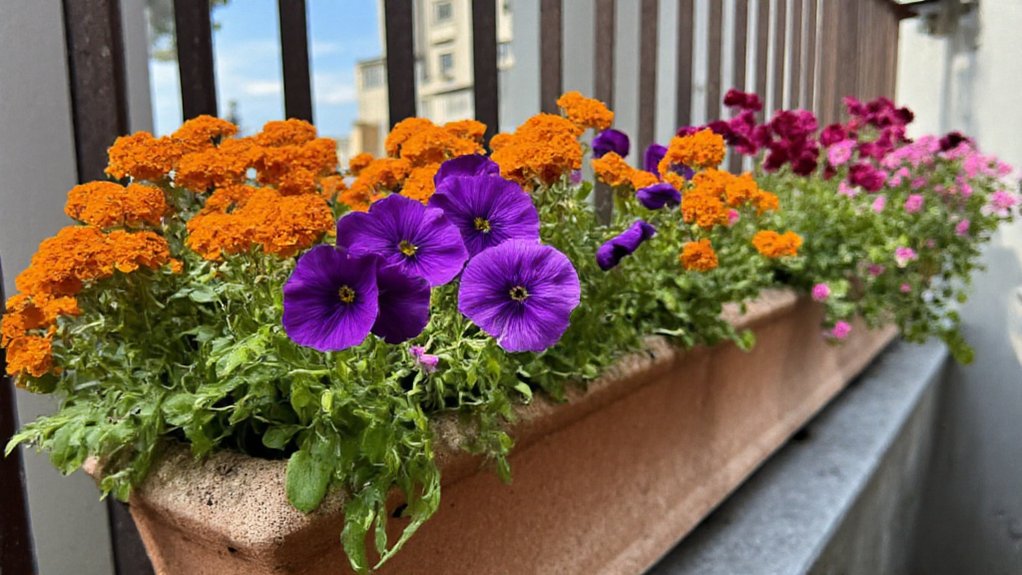
Adding color to your tiny balcony garden with seasonal flowers is a fantastic way to keep your space vibrant and ever-changing throughout the year. Seasonal flowers, such as pansies in spring, marigolds in summer, chrysanthemums in fall, and cyclamen in winter, can bring bursts of color and life to even the smallest of spaces. Choose flowers that thrive in your local climate and match the current season to guarantee they bloom beautifully with minimal effort.
You can plant these flowers in pots, hanging baskets, or window boxes to maximize your limited balcony space. Mixing different colors and varieties not only enhances the visual appeal but also attracts pollinators like bees and butterflies, adding a touch of nature to your urban oasis. Rotate your flower selection with the seasons to maintain a fresh and lively look year-round.
Install a Simple Trellis for Climbers
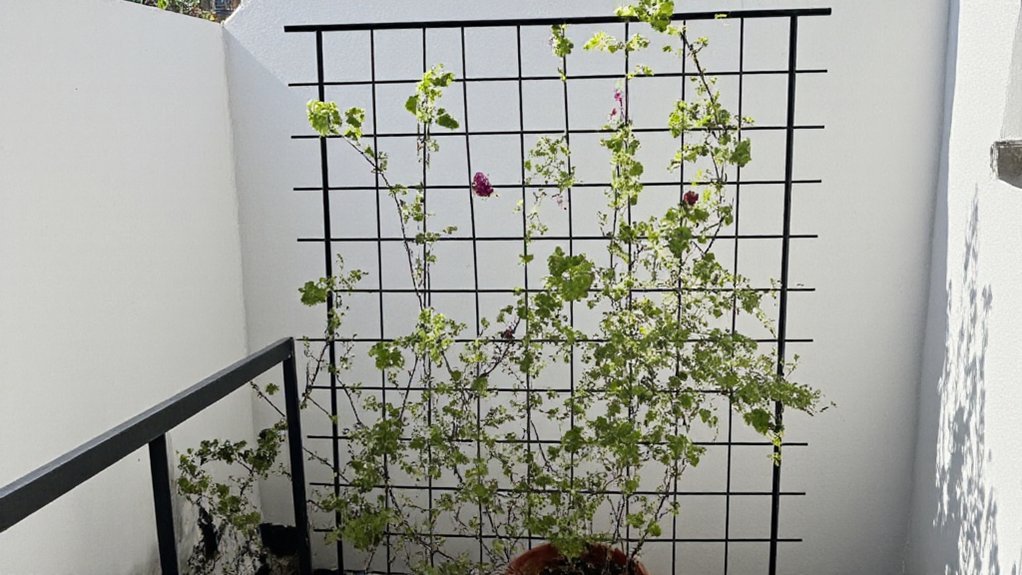
Installing a simple trellis on your tiny balcony can be a game-changer for growing climbing plants like ivy, clematis, or even small vegetables such as beans and peas. A trellis provides vertical support, allowing these plants to grow upwards and maximize your limited space while adding a lush, green aesthetic to your balcony. You can easily find affordable trellises at garden centers or online, or even create a DIY version using materials like wooden lattice, wire mesh, or sturdy string tied between posts.
To install, secure the trellis against a wall or railing, ensuring it is stable and can withstand wind or the weight of mature plants. Use wall anchors or heavy-duty zip ties to fasten it in place, and position it where your climbers will receive adequate sunlight. Once set up, guide the tendrils or vines of your plants onto the trellis, gently tying them with soft twine if needed, to encourage upward growth and create a beautiful vertical garden feature.
